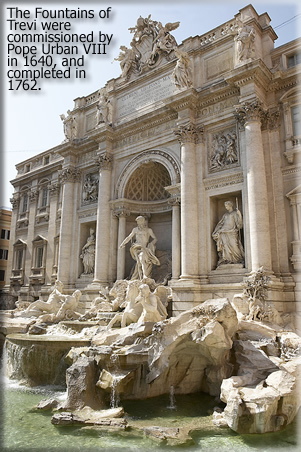
Rome has been called the most religious city in the world because of the number of her churches. With equal propriety, and perhaps with greater justice, she might be called the cleanest city in the world because of the number of her fountains. Pagan emperors and Christian popes alike have found both profit and pleasure in adding another fountain or in making or repairing one more aqueduct or fountain to give a still greater supply of water to the Roman populace.
- No other people, with the possible exception of the Spanish Moors, have so appreciated the value and the beauty of abundant water, fountains, and aqueducts.
- There are few squares, even in the modern Rome of today, where, at least in the silence of the night, the sound of of fountain splashing water may not be heard.
- The tiny fountain, often fern-fringed, with its ceaseless, slender stream of water, is the one priceless possession in hundreds of old courtyards, where it fills a damp and lonely silence with charm, or redeems by its indestructible quality of beauty the meanness of the squalid life about it.
- It is impossible to think of Rome without her fountains.
Yet, after a few weeks, the eye is hardly aware of their presence. It is as if by their very beauty and omnipresence they had acquired the divine attributes of sunlight; and it requires the silence, as with the sunlight it requires the cloud, to rouse our consciousness to their existence.
The fountains take their place among the elemental causes of happiness, since the pain we feel at their loss is the only adequate measure of the pleasure they give us. It is difficult for modern man to picture to himself the abundance and splendor of the fountains in Rome. Some idea of their character may be obtained from the description gathered from various sources of Nero’s fountain on the Caelian.
The mingled waters of the Claudian and the Anio Novus aqueducts were brought there over the Neronian arches.
- A wall fifty feet in height, faced with rare marbles and decorated by hemicycles and statues, formed the background of the first fountain cascade.
- At the foot of this wall a huge basin received the stream of water from the fountain, which then fell into another basin ten feet below the first, and thence flowed into the great artificial lake, described by Suetonius as like unto a sea, which filled all that space now occupied by the Coliseum.
- Of great magnificence also was the fountain of Severus Alexander on the Esquiline which served to introduce the Acqua Alexandrina, the eleventh and last water supply of imperial Rome. (Please note, this site does not sell Fountains.
- If you are looking for a Cast Stone Fountains or water features to buy, we suggest you visit
